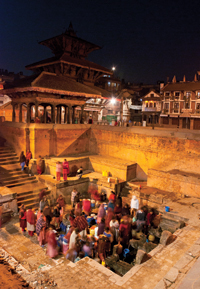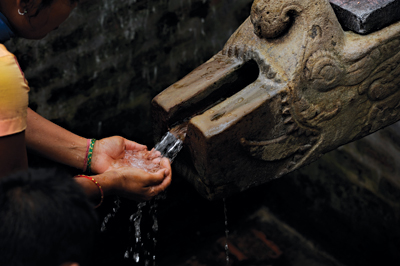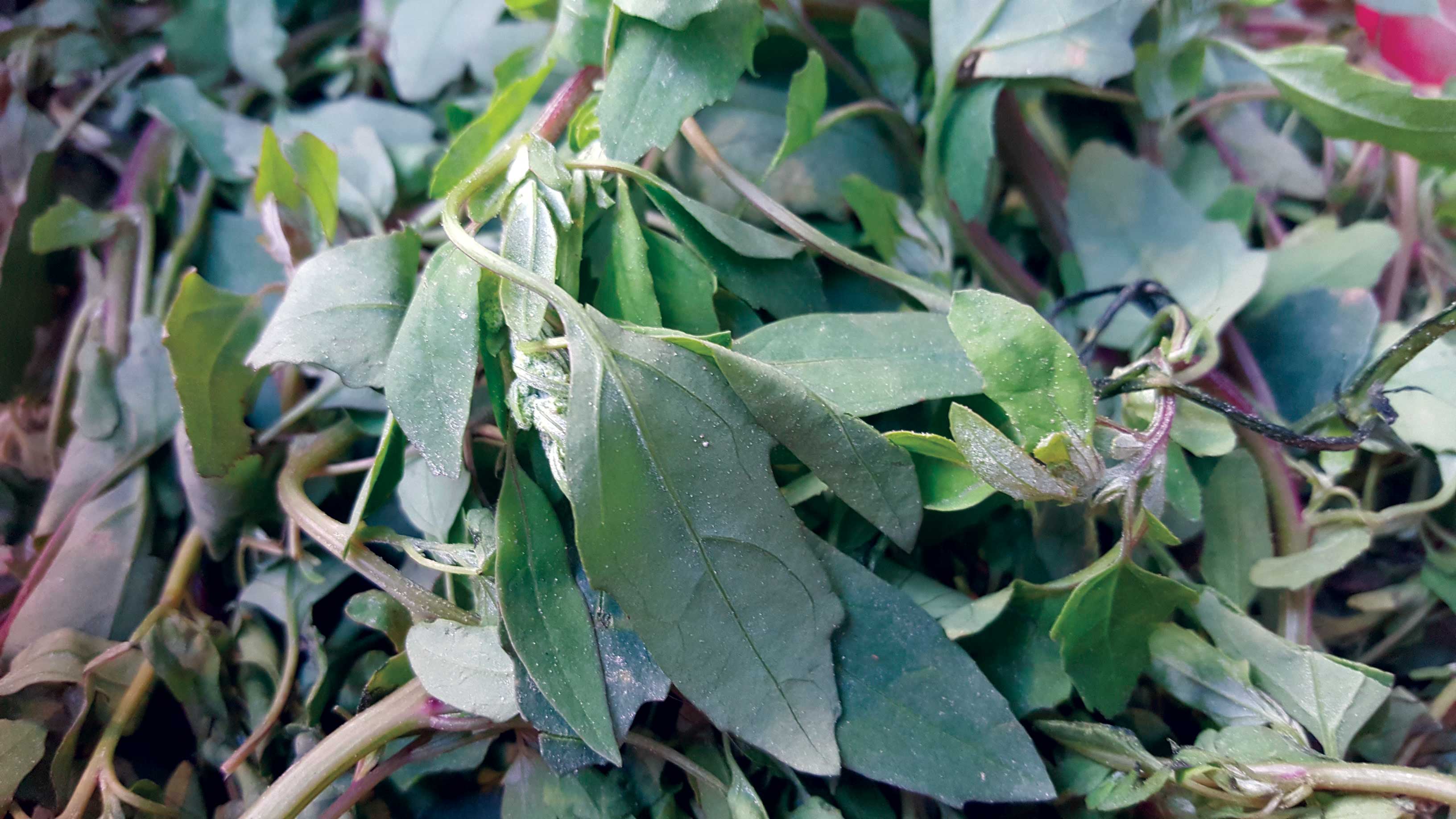Walking through old parts of the Kathmandu Valley, I sometimes go over to the edge of the road to look down into depressions that enclose stone spouts, or hitis, as they are called in Newari. Often, I find people in them, queued up to fill their containers with water from the spouts. This sight is however, becoming increasingly rare. Nowadays, these hitis are mostly empty. They wear a deserted look, the stone conduits shaped like animal heads, dry and lifeless. They seem to be waiting as much for compassion as for water. Some of them are completely dry; from others, water drips poignantly. The hitis, which once have buzzed with the sound of people talking as they waited for their jars to fill, are silent. Without water and people, these places look like a pit. In them, history seems to be dying a slow death.
 The drying up of hitis in the Kathmandu Valley is a result of a chain reaction. The hitis are fed by water from three kinds of sources: groundwater, rainwater and ponds. Kathmandu’s ground water reserves have come under relentless pressure from its growing population. Unsustainable extraction has drastically reduced the groundwater levels. Urbanization has also had an adverse impact. Since there are very few open spaces left now, less rainwater seeps into the ground than before. Most rainwater flows into the rivers and is wasted. This disruption in the recharging of the ground water further aggravates the water scarcity. The ponds of the valley, a vital source for its ancient water supply system, have become victims of encroachment. Patan alone is said to have had 39 ponds. Today, only 16 of those remain in their original size; nine have shrunk and 14 have dried up completely. The districts of Bhaktapur and Kathmandu have lost an even higher number of their ancient ponds.
The drying up of hitis in the Kathmandu Valley is a result of a chain reaction. The hitis are fed by water from three kinds of sources: groundwater, rainwater and ponds. Kathmandu’s ground water reserves have come under relentless pressure from its growing population. Unsustainable extraction has drastically reduced the groundwater levels. Urbanization has also had an adverse impact. Since there are very few open spaces left now, less rainwater seeps into the ground than before. Most rainwater flows into the rivers and is wasted. This disruption in the recharging of the ground water further aggravates the water scarcity. The ponds of the valley, a vital source for its ancient water supply system, have become victims of encroachment. Patan alone is said to have had 39 ponds. Today, only 16 of those remain in their original size; nine have shrunk and 14 have dried up completely. The districts of Bhaktapur and Kathmandu have lost an even higher number of their ancient ponds.
 In the past, these ponds were replenished by an ancient canal, known as the Rajkulo. The rajkulo was the most important and ingenious design in the valley’s water supply system. Kathmandu, Bhaktapur and Lalitpur each had a rajkulo of their own that fed their major ponds. Besides carrying water to the ponds, and through them to the hitis, the Rajkulo was designed to distribute water for irrigation. It was engineered so that besides carrying water from one place to another, it also collected it, minimizing surface water loss. “The Rajkulo was the equivalent of today’s water transmission pipes,” says Prayag Joshi, a water expert.
In the past, these ponds were replenished by an ancient canal, known as the Rajkulo. The rajkulo was the most important and ingenious design in the valley’s water supply system. Kathmandu, Bhaktapur and Lalitpur each had a rajkulo of their own that fed their major ponds. Besides carrying water to the ponds, and through them to the hitis, the Rajkulo was designed to distribute water for irrigation. It was engineered so that besides carrying water from one place to another, it also collected it, minimizing surface water loss. “The Rajkulo was the equivalent of today’s water transmission pipes,” says Prayag Joshi, a water expert.
The histories of the rajkulos of the valley’s three cities – Kathmandu, Lalitpur and Bhaktapur – are obscure and surrounded by myths. Not much is known about the origin of Kathmandu’s rajkulo. Even lesser is known about its present location; it has disappeared without a trace under the city. The history of the Lalitpur Rajkulo has two versions: the first mythical, the second factual. According to local folklore, the rajkulo dates back to 992 A.D., when a deity kidnapped a girl from Lalitpur. It is believed that Bal Kumari, the daughter of a certain Bal Deshar of Chapagaun, was kidnapped by a deity known as Tikabhairabh. Disguised as a man, Tikabhairabh approached the girl as she was guarding her father’s land, and carried her off. A man named Nagarkoti from the Chhampi village happened to see the entire incident and followed the deity. Realizing that he was being followed, the deity assumed his true form, introduced himself to the man, and asked him to inform Bal Deshar about his daughter’s kidnapping.
On hearing about his daughter’s kidnapping, Bala Deshar told Nagarkoti that he wished to meet his daughter. Nagarkoti then carried Deshar on his back to where Tikabhairabh lived but the deity refused to return Bala Deshar’s daughter, offering instead to grant him anything he asked for. Realizing that the deity wouldn’t return his daughter, Deshar decided to accept something in return. He asked the god to provide water for his village, Chapagaun. Tikabhairabh agreed to grant this request and asked Deshar to follow him with a shovel. Deshar dug a canal up to Chapagaun, which the god filled with water.
The descendents of Deshar and Nagarkoti are still believed to live in the Chapagaun and Chhampi villages today. To this day, members of the Nagarkoti family come to Chapagaun carrying pots of Chhyang - locally brewed rice beer. They then carry a member of the Deshar family to Tikabhairabh, just like their ancestors had carried Bala Deshar centuries ago. The two clans then perform a puja in honor of Tikabhairabh.
It is believed that Lalitpur’s Rajkulo originally ran up to Chapagaun. Siddhi Narasingh Malla, a Malla king i s said to have extended the canal to Patan. He brought the canal into the city to feed the Bhandarkhal Pokhari situated within his palace. This is probably why the canal is called rajkulo, meaning ‘royal canal’. Some people credit the king with building the entire 11.2 kilometers of the Rajkulo from its source in Tikabhairabh to Patan Durbar Square. An interesting feature of the canal, which mostly flowed on the surface, was that it flowed underground, at an average depth of 16 feet, from Lagankhel to the palace. Whether it was built by a deity in exchange for a bride or by a king for access to water, the Rajkulo mostly served the common people. In its heydays, the rajkulo carried water to irrigate around 1200 hectares of land. It brought water to 18 ponds within the old city of Patan and fed another five in the surrounding villages. The rajkulo also collected and deposited water to aquifers.
s said to have extended the canal to Patan. He brought the canal into the city to feed the Bhandarkhal Pokhari situated within his palace. This is probably why the canal is called rajkulo, meaning ‘royal canal’. Some people credit the king with building the entire 11.2 kilometers of the Rajkulo from its source in Tikabhairabh to Patan Durbar Square. An interesting feature of the canal, which mostly flowed on the surface, was that it flowed underground, at an average depth of 16 feet, from Lagankhel to the palace. Whether it was built by a deity in exchange for a bride or by a king for access to water, the Rajkulo mostly served the common people. In its heydays, the rajkulo carried water to irrigate around 1200 hectares of land. It brought water to 18 ponds within the old city of Patan and fed another five in the surrounding villages. The rajkulo also collected and deposited water to aquifers.
The history of the Bhaktapur Rajkulo is equally uncertain. Some attribute the construction of the rajkulo to the mythical queen Tula Maharani, who is believed to have weighed a mere 11 grams and who could walk across ponds by stepping on lotus leaves. Other legends speak of king Jitamitra Malla as being the one behind building the rajkulo. The discovery of inscriptions dating back to the Lichhavi period in several hitis of Bhaktapur suggests that the rajkulo was probably built by Tula Maharani, since she belonged to that period in time. King Jitamitra Malla probably expanded the canal system during his reign.
 There are no records to show who built the Kathmandu Rajkulo. Most historians credit King Pratap Malla with building it, based on the fact that he built the Rani Pokhari, which relied on the rajkulo for water.
There are no records to show who built the Kathmandu Rajkulo. Most historians credit King Pratap Malla with building it, based on the fact that he built the Rani Pokhari, which relied on the rajkulo for water.
Today, only the Lalitpur Rajkulo survives, although it’s been pushed to the periphery by rapid urbanization. Kathmandu has lost its rajkulo. Bhaktapur’s rajkulo has a slim chance of revival. Two years ago, the Lalitpur Sub-Metropolitan City and Environment and Heritage Conservation Nepal, an NGO, started work on reconstructing the rajkulo. The project was funded by the Indian Embassy. The first phase of the project is now complete and the rajkulo now runs up to Thecho, which is around five kilometers from Patan Durbar Square. It is estimated that the canal can now irrigate 600 hectares of land in Lalitpur. The project, however, has come to a standstill due to a dearth of funds. Sagar SJB Rana, Chairman of Environment and Heritage Conservation Nepal, feels a delay in action could have irreversible consequences. “If we don’t act now, within 15-20 years all the stone spouts of Lalitpur will dry up. This will hit the poor people harder than those of us who have running water at home,” he says. To him, they are more than just water-discharging structures. “Stone spouts are the most prominent cultural heritage of the Kathmandu Valley,” he says. The future of these cultural structures depends on the rajkulo. “If the rajkulo’s passage to Patan is restored, around 40 stone spouts will start working again,” says Prayag Joshi. The canal, when fully restored, will provide 40,000 people with safe drinking water. When the rajkulo restoration project is completed, it is expected to bring in 8 million liters of water every day into Lalitpur.
Today, the Rajkulo is more vital then ever. It’s not just a solution to the problem of water scarcity. If it flows back into the cities again, it will not only bring in water, refill old ponds and get water flowing out of the hitis, but also save a glorious part of our culture and heritage. And, history won’t die a lonely death down in the hitis; it will thrive there.










